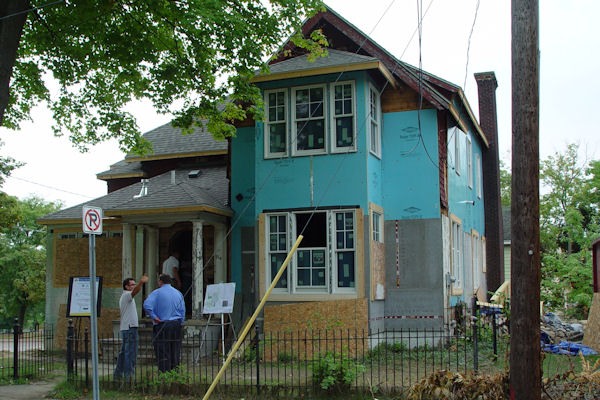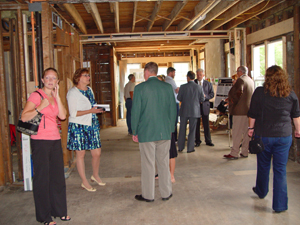UM-Flint "Urban Alternatives House" Prepares Second Launch

In October of 2010, a major University of Michigan-Flint project to create an urban living laboratory was turned into a pile of ashes. The Urban Alternatives House (UAH) was destroyed by arson.
Now, the plans, the partners, and the funding are in place to begin again. A house has been selected in Flint's Central Park Neighborhood at 924 Eddy St., and the university is collaborating with the Genesee County Land Bank to establish the new UAH.
The new house will be used as a classroom and laboratory to teach and explore better ideas for urban living. It will also contain two residential units. Renovations and remodeling has been underway at the house for the past several weeks.
On Friday, September 7 an open house was held to share information about this innovative learning project. Suppliers to the project displayed the latest energy-efficient products that are being used in the house.

"We are working with the Alliance for Environmental Sustainability to obtain LEED (Leadership in Energy and Environmental Design) for Homes certification for the project," said Associate Professor Richard Hill-Rowley. "When we do this, it will be the first project of its kind in Genesee County."
Specific features include:
– A geothermal heating and cooling system
– Enhanced insulation to create a tighter house envelope
– On-demand hot water heating
– A building monitoring system to gather data on the operation of house systems
– A solar energy system
"The renovated house will maximize energy efficiency, and introduce sustainable, innovative ways to manage energy and water use," said Hill-Rowley. "As collaborative partners, the University Michigan-Flint and the Genesee County Land Bank are working together to design and implement the project."
A vegetable garden will also be developed to encourage more active and healthy living, with both the garden and the landscape vegetation supported by a rain water collection system.
UM-Flint's major objectives for the project are:
– Teaching sustainable living and green building
– Supporting green building in the renovation of Genesee County Land Bank properties
– Promoting neighborhood stability
Funds to implement the renovation of the UAH property have been the responsibility of UM-Flint and the Land Bank. The Land Bank will support the residential components of the project with funds from the Neighborhood Stabilization Program (NSP2). UM-Flint has support from the Rotary Club of Flint, the C.S. Mott Foundation and Consumers Energy. The Kresge Foundation provided a major planning grant. All of these supporters will be recognized as lead partners. Critical funding from the Energy Conservation Fund of the Community Foundation of Greater Flint provided the solar energy component in collaboration with Mid-Michigan Solar.
VIDEO: "The First" Urban Alternatives House (October 2010)
Related Posts
No related photos.
UM-Flint News
The Office of Marketing & Communications can be reached at [email protected].